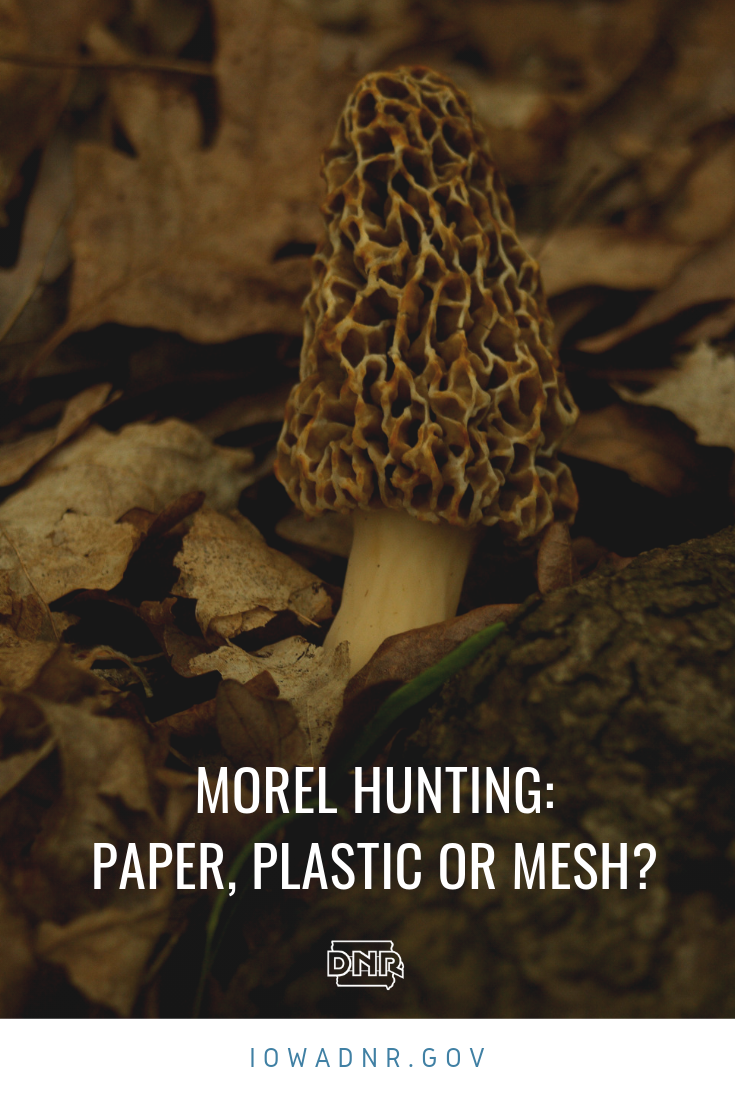From the Spring 2019 issue of Iowa Outdoors - subscribe now!
Seasoned morel mushroom hunters often advise novices to skip plastic and pack mesh bags when collecting Iowa’s spring delectable gift. They claim mesh bags allow morel spores to float to the timber floor to produce more of the golden treasures.
 The truth is, spores are dropped regardless of whether it’s a mesh, plastic or paper bag, advised Lois Tiffany, “Iowa’s Mushroom Lady” and botany professor at Iowa State University until her death in 2009.
The truth is, spores are dropped regardless of whether it’s a mesh, plastic or paper bag, advised Lois Tiffany, “Iowa’s Mushroom Lady” and botany professor at Iowa State University until her death in 2009.
She, along with the late ISU botany professor George Knaphus and professor Don Huffman of Central College in Pella, conducted a 10-year study on the distribution and ecology of morels. A better reason for using mesh bags, said Tiffany, is due to the heat and moisture plastic generates, which can taint the delicate fungi.
“You wouldn’t take a pound of hamburger and put it in a plastic bag and place it in the back window of your car for a couple hours,” she compared. “Morels are equally vulnerable to other bacteria contaminating the mushroom and becoming a problem.”
Mesh bags allow air to circulate, and create more opportunity for dirt and bugs to shake loose from the mushroom folds.
Tiffany debunks the long-held theory that mushroom hunters should leave some specimens for seed. “I can’t imagine any collecting group being thorough enough to collect every mushroom.”
Morel Tips
Use these mushroom hunting tips from mushroom clubs and skilled foragers to put more of these tasty fungi in the bag!
When to Look
Natural spring signs alert us as to when to look: oak leaves the size of a squirrel’s ears; lilac budding and ready to flower; may apple leaves opened up like umbrellas; trilliums, bloodroot, trout lily, Virginia bluebells, dandelion, spring beauty and columbine flowering.
Whether you want to follow the morels north with the spring, or wait until they reach your location, this is a great way to be in the know.
Track the progression of morels from Mexico to Canada at thegreatmorel.com.
Weather
The chances of finding morels improve when daytime temperatures reach the 60s and nighttime temperatures are in the 50s. More specifically, scientifically, a soil temperature of 53 degrees is the time to start looking.
Variables affecting this include type of soil (well-drained sandy soils warm up more quickly than clay soils), the degree that the ground slopes and its aspect (whether the slope faces north or south, for instance), the amount of sun or shade, soil moisture, the time of day, etc.
The temperature of the soil at one location can range as much as 8 degrees in a day. When everything else seems to be just right, a warm spring rain can trigger morel emergence.
An early warm spell in spring, where it cools off for a week or two before it gets warm again, plays havoc with hunting success. If you waited to hunt until after the second warming, your chance of finding morels is diminished.
As a general rule in Iowa, it is best to start looking in early April, and then continue to hunt through mid May.
Where to Look
Dead elms are a great place to look. The elms remaining produce a prodigious amount of winged seeds every spring in a battle to survive, and dying and dead elms may still be encountered while searching for morels.
“Your best luck,” says Dave Layton of the Prairie States Mushroom Club, “will be where the elm is still dying, or has died within the last year.” Such an elm will have most of its bark on it, but few, if any, leaves.